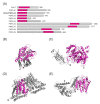Adipose Triglyceride Lipase Regulation: An Overview
- PMID: 28925902
- PMCID: PMC7613786
- DOI: 10.2174/1389203718666170918160110
Adipose Triglyceride Lipase Regulation: An Overview
Abstract
Adipose triglyceride lipase (ATGL) is the key-enzyme for the release of fatty acids (FAs) from triacylglycerol (TG) stores during intracellular lipolysis producing FAs used for energy production. There is growing evidence that the products and intermediates from lipolytic breakdown during the FA mobilization process also have fundamental regulatory functions affecting cell signaling, gene expression, metabolism, cell growth, cell death, and lipotoxicity. Regulation of ATGL is therefore vital for maintaining a defined balance between lipid storage and mobilization. This review addresses the regulation of ATGL activity at the post-translational level with special emphasis on protein-mediated interaction at the site of hydrolytic action, namely to the lipid droplet.
Keywords: ABHD5; ATGL; Atglistatin; CGI-58; CIDEC; FSP27; G0/G1 switch gene 2; G0S2; HILPDA; Lipolysis; PEDF; PNPLA2; Plin; SERPINF1; adipose triglyceride lipase; cell death activator CIDE-3; comparative gene identification 58; fat-specific protein 27; hypoxia-inducible lipid dropleT-associated; oleoyl-CoA; patatin-like phospholipase domain-containing protein 2; perilipin; pigment epithelium derived factor; serpin family F member 1; α/β hydrolase domain containing protein 5.
Copyright© Bentham Science Publishers; For any queries, please email at epub@benthamscience.org.
Figures



Similar articles
-
Adipose triglyceride lipase activity is inhibited by long-chain acyl-coenzyme A.Biochim Biophys Acta. 2014 Apr 4;1841(4):588-94. doi: 10.1016/j.bbalip.2014.01.005. Epub 2014 Jan 16. Biochim Biophys Acta. 2014. PMID: 24440819 Free PMC article.
-
Fat-specific protein 27 (FSP27) interacts with adipose triglyceride lipase (ATGL) to regulate lipolysis and insulin sensitivity in human adipocytes.J Biol Chem. 2014 Apr 25;289(17):12029-12039. doi: 10.1074/jbc.M113.539890. Epub 2014 Mar 13. J Biol Chem. 2014. PMID: 24627478 Free PMC article.
-
G0S2: A small giant controller of lipolysis and adipose-liver fatty acid flux.Biochim Biophys Acta Mol Cell Biol Lipids. 2017 Oct;1862(10 Pt B):1146-1154. doi: 10.1016/j.bbalip.2017.06.007. Epub 2017 Jun 21. Biochim Biophys Acta Mol Cell Biol Lipids. 2017. PMID: 28645852 Free PMC article. Review.
-
The ATGL lipase cooperates with ABHD5 to mobilize lipids for hepatitis C virus assembly.PLoS Pathog. 2020 Jun 15;16(6):e1008554. doi: 10.1371/journal.ppat.1008554. eCollection 2020 Jun. PLoS Pathog. 2020. PMID: 32542055 Free PMC article.
-
[Adipose triglyceride lipase regulates adipocyte lipolysis].Sheng Li Ke Xue Jin Zhan. 2008 Jan;39(1):10-4. Sheng Li Ke Xue Jin Zhan. 2008. PMID: 18357681 Review. Chinese.
Cited by
-
Approaches to Measuring the Activity of Major Lipolytic and Lipogenic Enzymes In Vitro and Ex Vivo.Int J Mol Sci. 2022 Sep 21;23(19):11093. doi: 10.3390/ijms231911093. Int J Mol Sci. 2022. PMID: 36232405 Free PMC article. Review.
-
Siah2 modulates sex-dependent metabolic and inflammatory responses in adipose tissue to a high-fat diet challenge.Biol Sex Differ. 2019 Apr 15;10(1):19. doi: 10.1186/s13293-019-0233-y. Biol Sex Differ. 2019. PMID: 30987673 Free PMC article.
-
The α/β-hydrolase domain-containing 4- and 5-related phospholipase Pummelig controls energy storage in Drosophila.J Lipid Res. 2019 Aug;60(8):1365-1378. doi: 10.1194/jlr.M092817. Epub 2019 Jun 4. J Lipid Res. 2019. PMID: 31164391 Free PMC article.
-
Insights into the mechanism of growth and fat deposition by feeding different levels of lipid provided by transcriptome analysis of swamp eel (Monopterus albus, Zuiew 1793) liver.Front Immunol. 2023 Jun 19;14:1118198. doi: 10.3389/fimmu.2023.1118198. eCollection 2023. Front Immunol. 2023. PMID: 37404827 Free PMC article.
-
Mutational scanning pinpoints distinct binding sites of key ATGL regulators in lipolysis.Nat Commun. 2024 Mar 21;15(1):2516. doi: 10.1038/s41467-024-46937-x. Nat Commun. 2024. PMID: 38514628 Free PMC article.
References
-
- Haemmerle G, Lass A, Zimmermann R, Gorkiewicz G, Meyer C, Rozman J, Heldmaier G, Maier R, Theussl C, Eder S, Kratky D, et al. Defective lipolysis and altered energy metabolism in mice lacking adipose triglyceride lipase. Science. 2006;312:734–7. - PubMed
-
- Zimmermann R, Strauss JG, Haemmerle G, Schoiswohl G, Birner-Gruenberger R, Riederer M, Lass A, Neuberger G, Eisenhaber F, Hermetter A, Zechner R. Fat mobilization in adipose tissue is promoted by adipose triglyceride lipase. Science. 2004;306:1383–6. - PubMed
-
- Haemmerle G, Zimmermann R, Hayn M, Theussl C, Waeg G, Wagner E, Sattler W, Magin TM, Wagner EF, Zechner R. Hormone-sensitive lipase deficiency in mice causes diglyceride accumulation in adipose tissue, muscle, and testis. J Biol Chem. 2002;277:4806–15. - PubMed
-
- Karlsson M, Contreras JA, Hellman U, Tornqvist H, Holm C. cDNA cloning, tissue distribution, and identification of the catalytic triad of monoglyceride lipase. Evolutionary relationship to esterases, lysophospholipases, and haloperoxidases. J Biol Chem. 1997;272:27218-23. - PubMed
Publication types
MeSH terms
Substances
Grants and funding
LinkOut - more resources
Full Text Sources
Other Literature Sources
Research Materials
Miscellaneous

